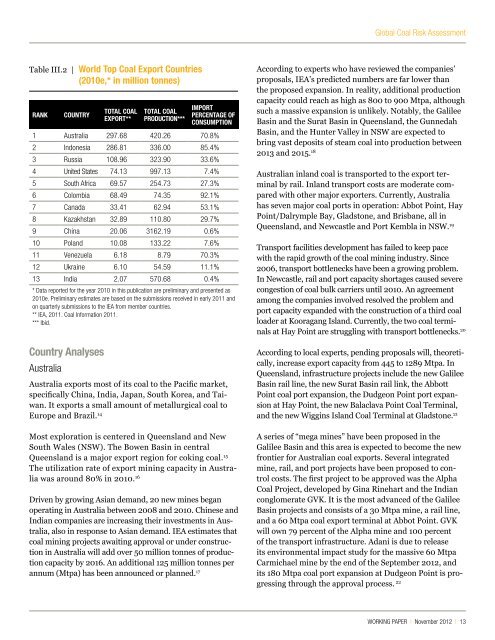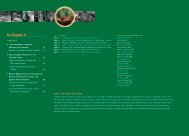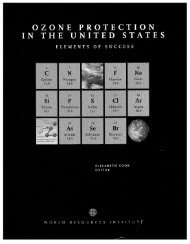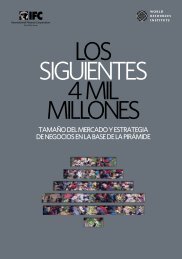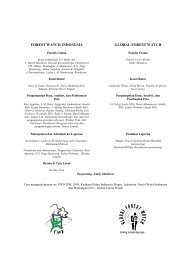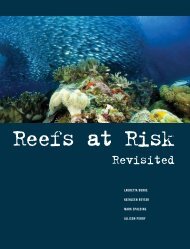GLObAL COAL RISK ASSESSmENT - World Resources Institute
GLObAL COAL RISK ASSESSmENT - World Resources Institute
GLObAL COAL RISK ASSESSmENT - World Resources Institute
Create successful ePaper yourself
Turn your PDF publications into a flip-book with our unique Google optimized e-Paper software.
Table III.2 | <strong>World</strong> Top Coal Export Countries<br />
(2010e,* in million tonnes)<br />
RANK COUNTRY<br />
Country Analyses<br />
Australia<br />
TOTAL <strong>COAL</strong><br />
EXPORT**<br />
TOTAL <strong>COAL</strong><br />
PRODUCTION***<br />
IMPORT<br />
PERCENTAGE OF<br />
CONSUMPTION<br />
1 Australia 297.68 420.26 70.8%<br />
2 Indonesia 286.81 336.00 85.4%<br />
3 Russia 108.96 323.90 33.6%<br />
4 United States 74.13 997.13 7.4%<br />
5 South Africa 69.57 254.73 27.3%<br />
6 Colombia 68.49 74.35 92.1%<br />
7 Canada 33.41 62.94 53.1%<br />
8 Kazakhstan 32.89 110.80 29.7%<br />
9 China 20.06 3162.19 0.6%<br />
10 Poland 10.08 133.22 7.6%<br />
11 Venezuela 6.18 8.79 70.3%<br />
12 Ukraine 6.10 54.59 11.1%<br />
13 India 2.07 570.68 0.4%<br />
* Data reported for the year 2010 in this publication are preliminary and presented as<br />
2010e. Preliminary estimates are based on the submissions received in early 2011 and<br />
on quarterly submissions to the IEA from member countries.<br />
** IEA, 2011. Coal Information 2011.<br />
*** Ibid.<br />
Australia exports most of its coal to the Pacific market,<br />
specifically China, India, Japan, South Korea, and Taiwan.<br />
It exports a small amount of metallurgical coal to<br />
Europe and Brazil. 14<br />
Most exploration is centered in Queensland and New<br />
South Wales (NSW). The Bowen Basin in central<br />
Queensland is a major export region for coking coal. 15<br />
The utilization rate of export mining capacity in Australia<br />
was around 80% in 2010. 16<br />
Driven by growing Asian demand, 20 new mines began<br />
operating in Australia between 2008 and 2010. Chinese and<br />
Indian companies are increasing their investments in Australia,<br />
also in response to Asian demand. IEA estimates that<br />
coal mining projects awaiting approval or under construction<br />
in Australia will add over 50 million tonnes of production<br />
capacity by 2016. An additional 125 million tonnes per<br />
annum (Mtpa) has been announced or planned. 17<br />
Global Coal Risk Assessment<br />
According to experts who have reviewed the companies’<br />
proposals, IEA’s predicted numbers are far lower than<br />
the proposed expansion. In reality, additional production<br />
capacity could reach as high as 800 to 900 Mtpa, although<br />
such a massive expansion is unlikely. Notably, the Galilee<br />
Basin and the Surat Basin in Queensland, the Gunnedah<br />
Basin, and the Hunter Valley in NSW are expected to<br />
bring vast deposits of steam coal into production between<br />
2013 and 2015. 18<br />
Australian inland coal is transported to the export terminal<br />
by rail. Inland transport costs are moderate compared<br />
with other major exporters. Currently, Australia<br />
has seven major coal ports in operation: Abbot Point, Hay<br />
Point/Dalrymple Bay, Gladstone, and Brisbane, all in<br />
Queensland, and Newcastle and Port Kembla in NSW. 19<br />
Transport facilities development has failed to keep pace<br />
with the rapid growth of the coal mining industry. Since<br />
2006, transport bottlenecks have been a growing problem.<br />
In Newcastle, rail and port capacity shortages caused severe<br />
congestion of coal bulk carriers until 2010. An agreement<br />
among the companies involved resolved the problem and<br />
port capacity expanded with the construction of a third coal<br />
loader at Kooragang Island. Currently, the two coal terminals<br />
at Hay Point are struggling with transport bottlenecks. 20<br />
According to local experts, pending proposals will, theoretically,<br />
increase export capacity from 445 to 1289 Mtpa. In<br />
Queensland, infrastructure projects include the new Galilee<br />
Basin rail line, the new Surat Basin rail link, the Abbott<br />
Point coal port expansion, the Dudgeon Point port expansion<br />
at Hay Point, the new Balaclava Point Coal Terminal,<br />
and the new Wiggins Island Coal Terminal at Gladstone. 21<br />
A series of “mega mines” have been proposed in the<br />
Galilee Basin and this area is expected to become the new<br />
frontier for Australian coal exports. Several integrated<br />
mine, rail, and port projects have been proposed to control<br />
costs. The first project to be approved was the Alpha<br />
Coal Project, developed by Gina Rinehart and the Indian<br />
conglomerate GVK. It is the most advanced of the Galilee<br />
Basin projects and consists of a 30 Mtpa mine, a rail line,<br />
and a 60 Mtpa coal export terminal at Abbot Point. GVK<br />
will own 79 percent of the Alpha mine and 100 percent<br />
of the transport infrastructure. Adani is due to release<br />
its environmental impact study for the massive 60 Mtpa<br />
Carmichael mine by the end of the September 2012, and<br />
its 180 Mtpa coal port expansion at Dudgeon Point is progressing<br />
through the approval process. 22<br />
WORKING PAPER | November 2012 | 13


